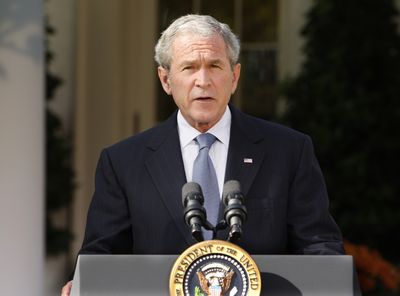U.S. will buy stakes in banks
Paulson reverses position; stocks fall again

WASHINGTON – In an extraordinary response to the escalating financial crisis, Treasury Secretary Henry Paulson Jr. on Friday said the government would buy direct stakes in banks and other financial institutions for the first time since the Great Depression.
Paulson initially dismissed the idea of taking equity stakes in crippled banks, and his change of heart may reflect a growing conviction that the severity of the credit crisis warrants a more direct approach. The Treasury plan aims to help banks rapidly shore up dwindling capital so they will be more willing to lend to businesses, individuals and each other.
The announcement followed Wall Street’s most tumultuous week ever, including a historically volatile session Friday that saw the Dow Jones industrial average whipsaw over a range of 1,000 points. The Dow fell for an eighth straight day and posted its biggest weekly loss in its 112-year history.
Paulson said the Treasury Department was working on a plan to buy equity in “a broad array of financial institutions,” using some of the $700 billion in the financial rescue package approved by Congress last week.
The equity would be in the form of nonvoting shares, a move which may temper the government’s ability to meddle with management.
The Treasury secretary made the announcement after emerging from a meeting of finance ministers and central bankers of the world’s leading industrial democracies. Following the first day of their two-day meeting in Washington, the G-7 issued a five-point plan, promising “urgent and exceptional action” to address the crisis. But while the finance ministers pledged to work cooperatively on the same goals, they did not commit to a specific plan.
That poses the possibility that disappointment over the limited scope of the communique will drive stock markets lower again Monday.
Many economists and investment professionals have been hoping that the G-7 meeting would produce a concrete coordinated international plan to address the spreading global credit crunch.
Paulson dismissed that suggestion.
“Some in the press and some in the markets are naive if they think that different countries with different financial systems, economies in different stages of development … and different political systems, different laws, are going to come up with precisely the same policy to deal with the issues,” he said.
But he added that all participants at the meeting agreed that strong steps were necessary.
“This is a period like none of us has ever seen before,” he said. “What came out of the meeting is there weren’t differences in what we need to do.”
At the White House earlier in the day, President Bush said, “We’re in this together, and we’ll come through this together.” He added, “Anxiety can feed anxiety, and that can make it hard to see all that’s being done to solve the problem.”
He made it clear the United States must work with other countries to battle the worst financial crisis that has jolted the world economy in more than a half-century.
“We’ve seen that problems in the financial system are not isolated to the United States,” he said. “So we’re working closely with partners around the world to ensure that our actions are coordinated and effective.”
Treasury’s equity-purchase program was widely favored by economists, who argued it would be preferable to the approach of buying bad mortgage securities from banks, the centerpiece of the financial bailout bill.
“Buying mortgage assets is plagued with problems,” said R. Glenn Hubbard, dean of the Columbia Business School and former chairman of Bush’s council of economic advisers.
Hubbard made his comment shortly before the Paulson announcement, but after it became clear that the secretary was leaning toward the new approach.
“It’s very helpful that Treasury is pivoting in this direction,” he said. “This is a crisis that policy can fix – it’s not beyond our ability.”
Paulson offered few details about the equity program, declining to say how much of the $700 billion would go to such purchases. He said officials were “working around the clock” to develop the program.
In recent weeks, the Treasury and Federal Reserve System have taken unprecedented steps to protect the economy from the effects of the global credit crisis. And much more aggressive steps are looming, say government and economic observers.
The Fed, for example, has moved to thaw out the commercial paper market – the provider of short-term loans for companies ranging from massive conglomerates to provincial manufacturing firms. The central bank’s announcement this week that it would create a “backstop facility” – essentially a form of guarantee – for commercial paper began to lower interest rates on the debt for some borrowers within a day or so.
Many economists and finance experts say the latest round of initiatives, along with those being telegraphed by government officials, suggest that policy-makers are pulling out all the stops in attempting to unlock the credit crunch.
Some also suggest that the current approach still has several gaps – including more direct efforts to shore up home prices and reduce foreclosures, and more coordinated international initiatives to restore confidence in the global banking system, largely by providing banks with capital and insuring deposits.